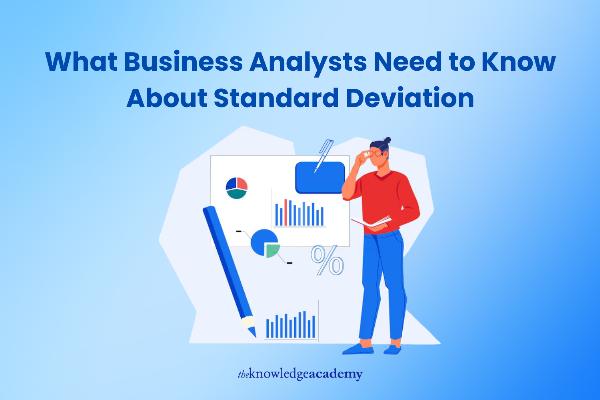What Business Analysts Need to Know About Standard Deviation

Strong 8k brings an ultra-HD IPTV experience to your living room and your pocket.
If you’re a business analyst, diving deep into data is part of your day-to-day life. But how can you make sense of all those numbers? Here's where understanding the concept of standard deviation becomes crucial. Ever wondered, What is Standard Deviation? It's a statistical measure that tells us how much variation or dispersion exists from the average (mean) of a set of data. In simpler terms, it shows whether your data points are close to the mean or spread out over a wide range. For business analysts, mastering standard deviation means better insights into risk assessments, performance metrics, and much more.
Table of Contents
- Why Standard Deviation Matters in Business Analysis
- Decoding Data Distribution
- Risk Management and Standard Deviation
- Optimising Operational Efficiency
- Forecasting and Predictive Analysis
- Enhancing Marketing Strategies
- Balancing Customer Satisfaction and Service Delivery
- Training and Skill Development
- Conclusion
Why Standard Deviation Matters in Business Analysis
In the realm of business analysis, standard deviation serves as a measure of clarity. When evaluating the performance of different departments or products, a low standard deviation indicates consistency. This consistency can be a sign of stability and control, attributes highly valued in any business operation. Conversely, a high standard deviation might flag potential issues or opportunities for improvement. It can indicate variability in processes that may require standardisation or adaptation.
Decoding Data Distribution
Understanding the spread of your data points is essential, and standard deviation gives you exactly that insight. It helps in identifying whether the data conforms to a normal distribution, which is critical in many statistical tests and predictive modelling. For instance, if customer satisfaction scores from a recent survey have a high standard deviation, as a business analyst, you'd probe further into the data. Are there outliers affecting the scores? Is there a particular aspect of the service that is causing dissatisfaction among a subset of customers?
Risk Management and Standard Deviation
Risk management is another area where standard deviation shines. It quantifies uncertainty, which is a key aspect of risk. For example, if you're assessing investment options, those with higher standard deviations are considered more volatile and riskier. However, they might also offer higher returns. By analysing these metrics, you can provide strategic insights that balance risk and reward according to the company's risk appetite.
Optimising Operational Efficiency
Standard deviation also aids in streamlining operations. By analysing variations in manufacturing processes or delivery times, you can pinpoint inefficiencies. This statistical tool allows you to identify when a process is deviating from its expected performance, prompting timely interventions. Improved consistency, achieved by understanding and acting on these deviations, directly enhances overall operational efficiency and customer satisfaction.
Forecasting and Predictive Analysis
In forecasting, standard deviation helps predict future trends based on historical data. It plays a crucial role in predictive analysis by setting confidence intervals around forecasts. This is particularly useful in inventory management and budget forecasting, where predicting future needs accurately can lead to significant cost savings and increased efficiency.
Enhancing Marketing Strategies
For marketing strategies, knowing the standard deviation of customer behaviour patterns, purchase frequencies, and campaign responses can transform how strategies are crafted. This knowledge allows for the creation of more targeted campaigns that are more likely to resonate with specific customer segments, thus increasing the effectiveness of marketing efforts.
Balancing Customer Satisfaction and Service Delivery
Exploring standard deviation helps manage customer satisfaction. A low standard deviation in customer feedback indicates uniform service quality, a strong point for promoting brand reliability. Conversely, a high standard deviation suggests variability in service, pinpointing areas needing improvement. By analysing these patterns, business analysts can guide enhancements in service processes, boosting overall customer experience and reinforcing the brand's reputation for consistency.
Training and Skill Development
Lastly, understanding standard deviation is not just about applying it to tasks but also about communicating its importance across teams. Training sessions and workshops that elucidate how this statistical measure can influence decision-making processes are invaluable. They empower teams to integrate data analytics into their routine decision-making process, enhancing the analytical culture within the organisation.
Conclusion
For business analysts, standard deviation is not just a statistical tool, but a lens through which the health and effectiveness of business processes can be viewed. It provides insights that go beyond averages and simple totals, offering a deeper understanding of the underlying dynamics of business operations. Mastery of this concept can elevate your analytical capabilities, making you an indispensable part of your organisation's strategic planning and operational execution. Whether it's risk management, operational efficiency, or strategic decision-making, standard deviation has a pivotal role to play in shaping business insights.
Note: IndiBlogHub features both user-submitted and editorial content. We do not verify third-party contributions. Read our Disclaimer and Privacy Policyfor details.







